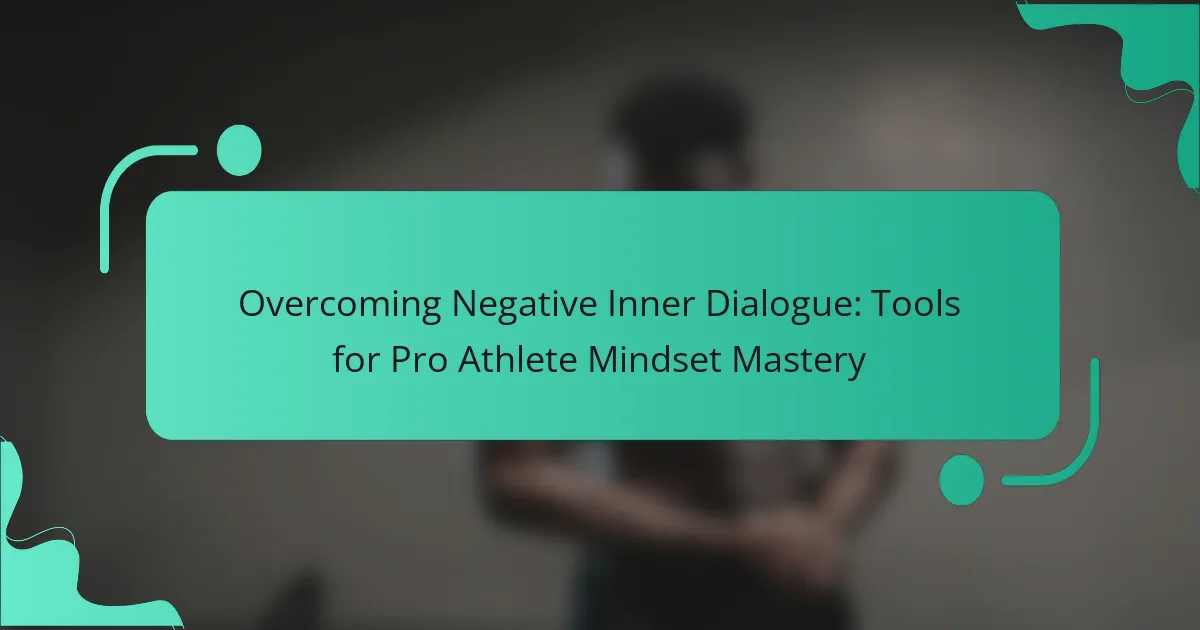Negative inner dialogue can significantly impact pro athletes’ performance and confidence. This article explores cognitive restructuring to reframe thoughts, mindfulness practices to enhance self-awareness, and visualization strategies to build confidence. These tools collectively foster a resilient mindset essential for peak performance. Additionally, unique techniques like biofeedback can further aid in managing stress and overcoming mental barriers.
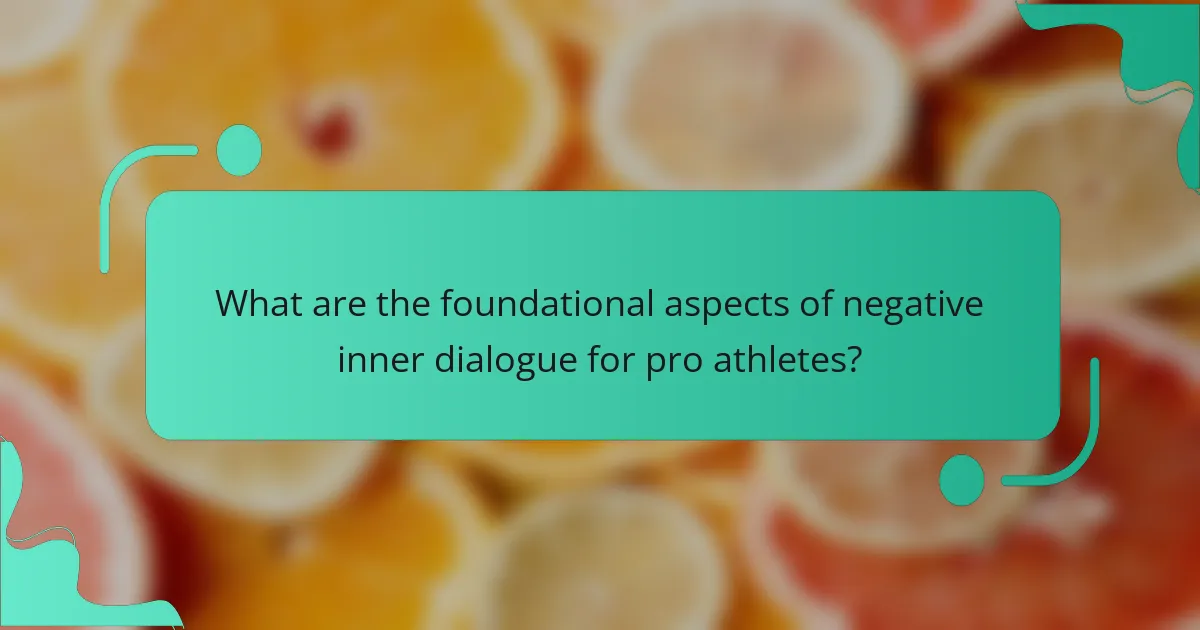
What are the foundational aspects of negative inner dialogue for pro athletes?
Negative inner dialogue can hinder pro athletes’ performance and confidence. Foundational aspects include self-doubt, fear of failure, and comparison to peers. These thoughts can create mental barriers, impacting focus and motivation. Effective tools for overcoming this dialogue involve cognitive restructuring, mindfulness practices, and positive affirmations, which help reframe negative thoughts into constructive ones.
How does negative inner dialogue impact performance?
Negative inner dialogue significantly hinders performance by fostering self-doubt and anxiety. This mental barrier can lead to decreased focus and motivation, ultimately impairing an athlete’s ability to execute skills effectively. Research shows that athletes who engage in positive self-talk outperform those with negative inner dialogue. Developing tools to counteract this negativity, such as visualization and affirmations, is essential for mastering a pro athlete mindset.
What are common triggers of negative inner dialogue in sports?
Common triggers of negative inner dialogue in sports include self-doubt, fear of failure, and comparison to others. These factors can undermine confidence and performance. Athletes often experience heightened pressure during competitions, leading to critical self-talk. Additionally, past negative experiences can resurface, reinforcing a negative mindset. Recognizing these triggers is essential for developing strategies to counteract them effectively.
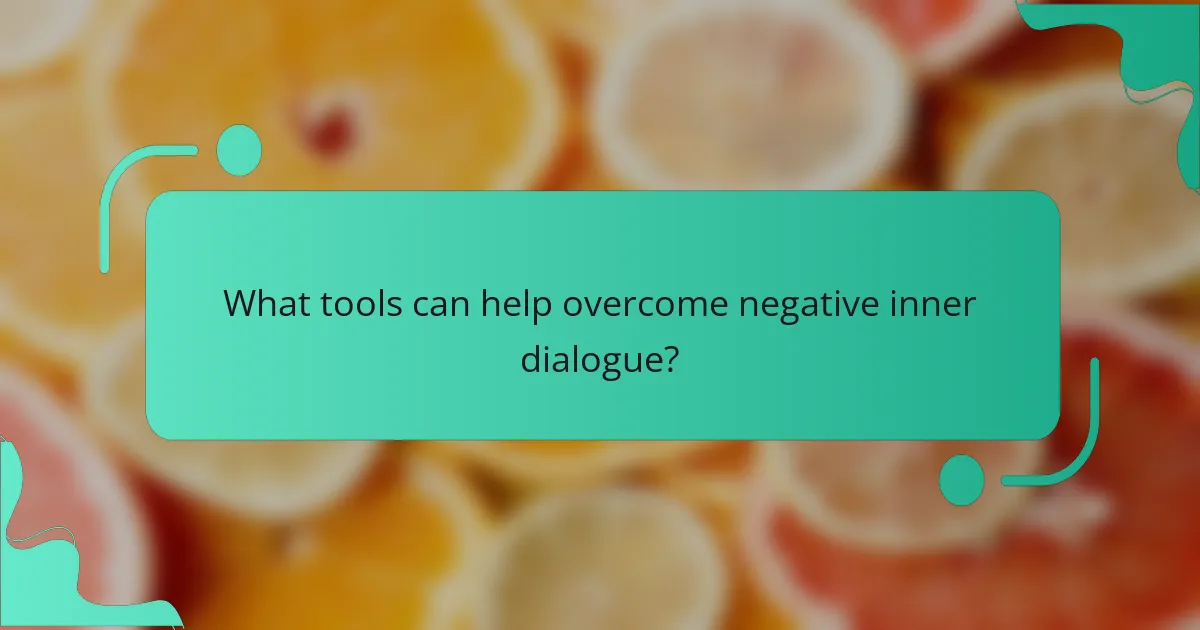
What tools can help overcome negative inner dialogue?
To overcome negative inner dialogue, pro athletes can use cognitive behavioral techniques, mindfulness practices, and visualization strategies. Cognitive restructuring helps reframe negative thoughts into positive affirmations. Mindfulness enhances self-awareness and reduces stress, while visualization builds confidence through mental rehearsal. These tools collectively foster a resilient mindset essential for peak performance.
How can cognitive restructuring techniques be applied?
Cognitive restructuring techniques can be applied by identifying negative thoughts, challenging their validity, and replacing them with positive affirmations. This process enhances mental resilience in athletes. Techniques include journaling to track thoughts, visualization to reinforce positive imagery, and practicing mindfulness to maintain focus. Regular application of these strategies can significantly improve performance and mindset.
What are practical steps for cognitive restructuring?
To overcome negative inner dialogue, pro athletes can implement cognitive restructuring through these practical steps:
1. Identify negative thoughts by monitoring self-talk during training and competition.
2. Challenge these thoughts by questioning their validity and considering alternative perspectives.
3. Replace negative thoughts with positive affirmations or constructive feedback.
4. Practice mindfulness techniques to stay present and reduce rumination on past mistakes.
5. Visualize successful performances to reinforce a positive mindset.
6. Seek support from coaches or mental health professionals to enhance emotional resilience.
What role does visualization play in overcoming negativity?
Visualization plays a crucial role in overcoming negativity by enabling athletes to reframe their inner dialogue. This technique allows them to create mental images of success, reinforcing positive outcomes and reducing self-doubt. By vividly imagining their goals and the steps to achieve them, athletes can shift their focus from negative thoughts to constructive actions. Visualization not only enhances confidence but also conditions the mind to respond positively in challenging situations, fostering resilience and mental strength.
How can athletes effectively use visualization?
Athletes can effectively use visualization by creating detailed mental images of their performance. This technique helps combat negative inner dialogue and enhances focus.
Visualization should include specific scenarios, such as executing a perfect routine or overcoming obstacles. Practicing this regularly can improve confidence and mental resilience.
Athletes can also integrate visualization into their training regimen, using it before competitions to mentally rehearse strategies and outcomes. This approach can lead to improved performance and a stronger mindset.
By consistently applying visualization techniques, athletes can transform their internal dialogue, fostering a positive mental environment conducive to success.
What are the benefits of positive self-talk?
Positive self-talk enhances mental resilience, boosts confidence, and improves performance in athletes. It fosters a constructive mindset, enabling athletes to overcome challenges. Research shows that athletes engaging in positive self-talk experience reduced anxiety and increased focus. This practice can lead to a unique attribute of enhanced competitive edge, as it cultivates a proactive and optimistic outlook. By consistently utilizing positive affirmations, athletes can develop a rare attribute of improved emotional regulation, which is crucial for maintaining peak performance under pressure.
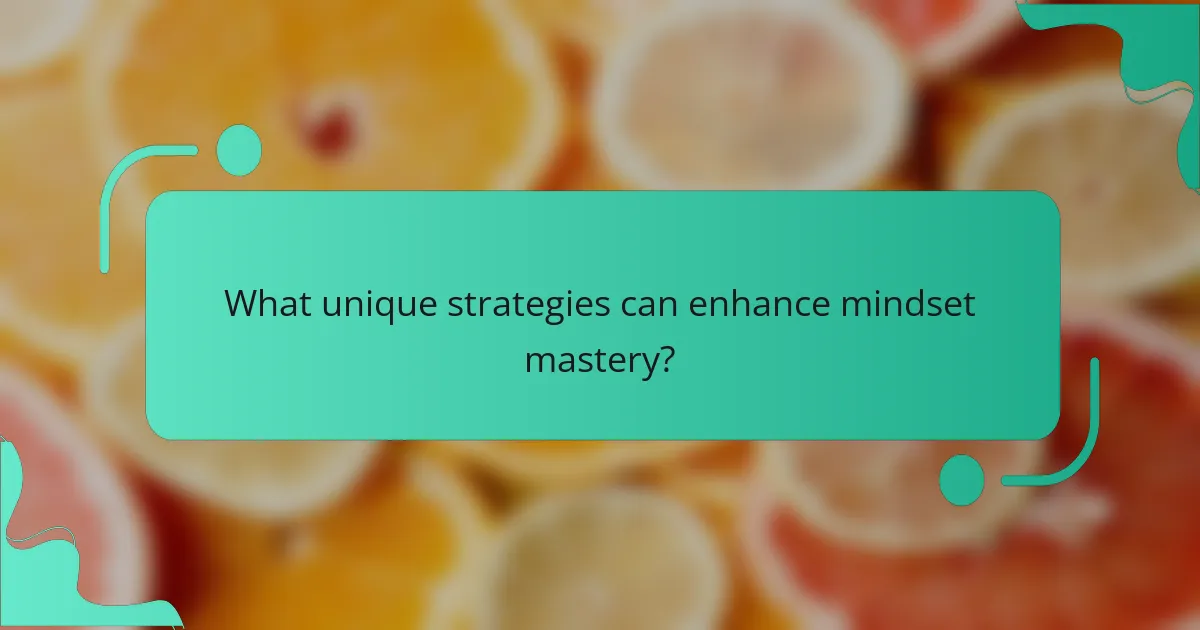
What unique strategies can enhance mindset mastery?
To enhance mindset mastery, pro athletes can implement unique strategies that focus on reframing negative inner dialogue. Techniques such as visualization, affirmations, and mindfulness meditation can shift mental patterns. Visualization enables athletes to mentally rehearse successful performances, reinforcing positive outcomes. Affirmations help in building self-confidence by countering negative thoughts with empowering statements. Mindfulness meditation cultivates awareness of thoughts, allowing athletes to recognize and challenge negative inner dialogue. These strategies collectively foster resilience and improve overall performance.
How can mentorship influence mindset and dialogue?
Mentorship significantly enhances mindset and dialogue by providing guidance and support. Pro athletes often face mental challenges that can lead to negative inner dialogue. A mentor helps athletes reframe their thoughts, encouraging a growth mindset. This shift fosters positive self-talk, leading to improved performance and resilience. Mentorship also facilitates open dialogue, allowing athletes to express concerns and receive constructive feedback. This relationship builds confidence, reinforcing the athlete’s belief in their abilities and potential.
What innovative technologies support mental training?
Innovative technologies supporting mental training include virtual reality, biofeedback devices, and mobile applications. These tools enhance focus, reduce anxiety, and improve overall mental resilience.
Virtual reality creates immersive environments for athletes to practice mental scenarios. Biofeedback devices measure physiological responses, allowing athletes to train their mental states effectively. Mobile applications offer guided meditations and cognitive exercises tailored for performance enhancement.
These technologies are essential for overcoming negative inner dialogue and mastering a pro athlete mindset.
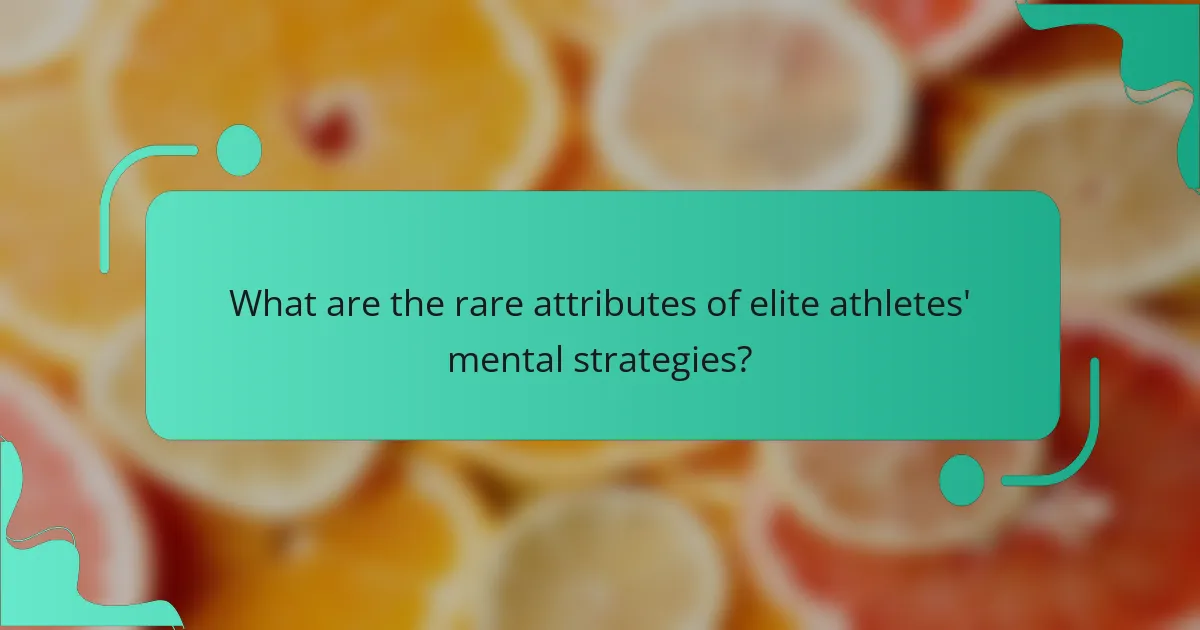
What are the rare attributes of elite athletes’ mental strategies?
Elite athletes often employ rare mental strategies to overcome negative inner dialogue. These strategies include visualization techniques, where athletes create vivid mental images of success, and cognitive restructuring, which involves reframing negative thoughts into positive affirmations. Another unique approach is mindfulness meditation, allowing athletes to stay present and reduce anxiety. Additionally, some athletes utilize biofeedback mechanisms to gain awareness of their physiological responses, helping them manage stress effectively. These rare attributes contribute significantly to their overall mental resilience and performance.
How do elite athletes maintain mental resilience under pressure?
Elite athletes maintain mental resilience under pressure through techniques that combat negative inner dialogue. They utilize visualization, mindfulness, and positive self-talk to enhance focus and confidence. These tools help them reframe challenges as opportunities, fostering a growth mindset. Research indicates that athletes who practice these methods experience reduced anxiety and improved performance during high-stakes situations.
What uncommon practices do top athletes use to combat negativity?
Top athletes often use uncommon practices like visualization, gratitude journaling, and mindfulness meditation to combat negativity. These techniques help shift their focus and enhance mental resilience.
Visualization involves imagining successful outcomes, which can create a positive mindset. Gratitude journaling allows athletes to reflect on their achievements and support systems, fostering a sense of appreciation. Mindfulness meditation encourages present-moment awareness, reducing anxiety and negative thoughts.
Incorporating these practices can empower athletes to maintain a strong mental state, ultimately improving performance.
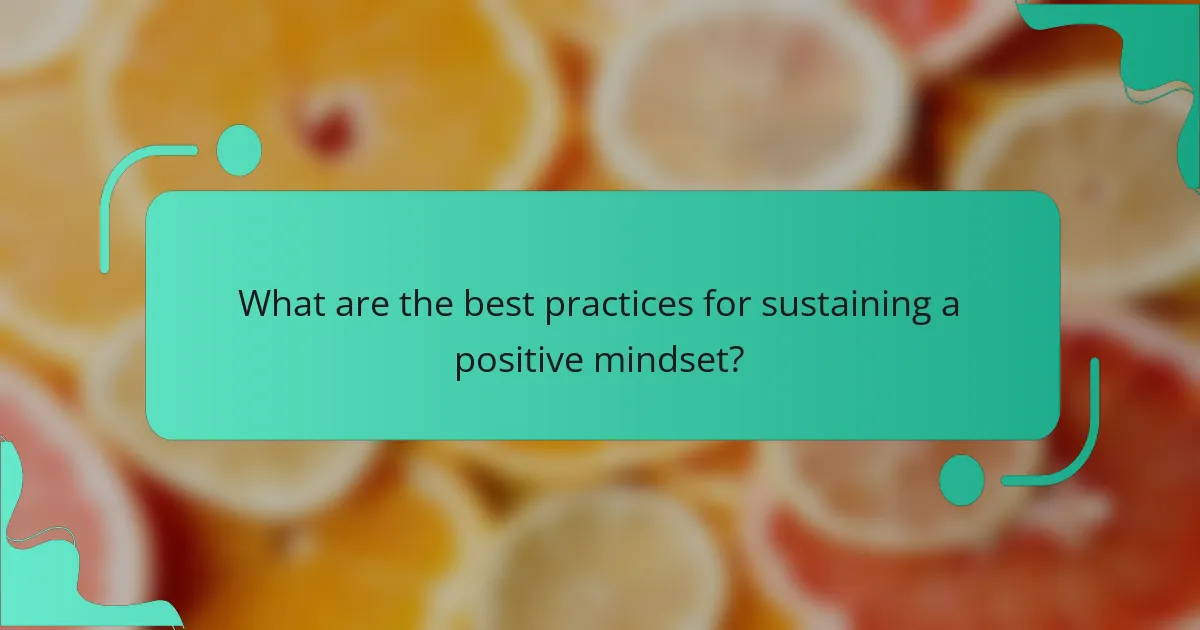
What are the best practices for sustaining a positive mindset?
To sustain a positive mindset, pro athletes can employ various strategies to overcome negative inner dialogue. Techniques such as visualization enhance focus and self-belief. Regular mindfulness practices, like meditation, reduce stress and improve emotional regulation. Engaging in positive self-talk reinforces confidence and counters doubt. Setting achievable goals fosters a sense of accomplishment, while surrounding oneself with supportive peers creates a positive environment. Embracing challenges as opportunities for growth is essential for resilience.
How can athletes create a personalized mental toolkit?
Athletes can create a personalized mental toolkit by identifying effective techniques to counter negative thoughts. This toolkit may include visualization, positive affirmations, and mindfulness practices. Each tool should be tailored to the athlete’s unique experiences and challenges, fostering resilience and focus. Regularly revisiting and adapting these tools enhances their effectiveness in overcoming mental barriers.
What common mistakes should athletes avoid in mental training?
Athletes should avoid negative self-talk, unrealistic expectations, and neglecting mental recovery. Fostering a positive inner dialogue enhances performance. Focusing on progress, not perfection, supports a healthy mindset. Regular mental training sessions can help build resilience and confidence.
What expert insights can enhance mindset mastery for athletes?
To enhance mindset mastery for athletes, focus on overcoming negative inner dialogue through specific techniques. Cognitive restructuring helps in identifying and changing unhelpful thoughts. Visualization can create positive mental imagery, boosting confidence and performance. Mindfulness practices cultivate present-moment awareness, reducing anxiety and enhancing focus. Regular goal-setting aligns efforts with clear objectives, fostering a sense of purpose. Engaging with a sports psychologist provides tailored strategies for individual challenges, promoting resilience and mental toughness.
